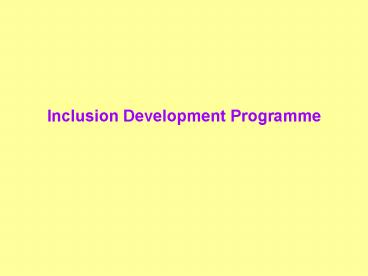Inclusion Development Programme PowerPoint PPT Presentation
1 / 24
Title: Inclusion Development Programme
1
Inclusion Development Programme
2
IDP Background
- Removing Barriers to Achievement, 2004
- IDP originally proposed in the governments SEN
strategy - National Curriculum Statutory Inclusion
statement 2000 2007 - Schools have a responsibility to provide a
broad and balanced curriculum for all pupils. The
National Curriculum is the starting point for
planning a school curriculum that meets the
specific needs of individuals and groups of
pupils. - The Inclusion Statement sets out three key
principles for effective inclusion - Setting suitable learning challenges
- Responding to pupils' diverse learning needs
- Overcoming potential barriers to learning and
assessment for individuals and groups of pupils.
3
IDP
- Four-year CPD programme
- Designed to increase confidence and expertise of
mainstream practitioners in meeting high
incidence of SEN in mainstream settings and
schools. - Aims to support schools and Early Years settings
through web-based materials - teaching and learning resources
- training materials
- guidance on effective classroom strategies
- models of good practice for multi-disciplinary
teams - information about sources of more specialist
advice. - First year focus
- dyslexia and speech, language and communication
needs (SLCN) - Following years
- autistic spectrum disorders (ASDs),
- behavioural, emotional and social difficulties
(BESD) and - moderate learning difficulties (MLD).
4
Caveat
- The IDP resource does NOT intend to provide
high-level specialist training. - It seeks to increase the confidence of teachers
and others in the identification and support for
aspects of SEN relating to literacy. - The focus is on good quality first teaching (QFT)
5
Waves of intervention model
The model enables systematic planning of
provision. The waves are ways of categorising
provision, not pupils
6
Inclusive teaching
- Is set within a culture of high expectations for
all. - Emphasises what a child will learn rather than
the activities they will do. - Is based on an assessment of what the children
already know, can do and understand. - Uses teaching styles that meet the needs of
individuals and groups so that all children are
engaged in learning. - Establishes access strategies that will help
overcome the potential barriers to learning
taking place.
7
The circles of inclusion
Responding to pupils diverse needs
Setting suitable learning challenges
Overcoming potential barriers to learning
8
IDP Dyslexia and SLCN
- Purpose
- To support HT and SMT in planning to raise
attainment of - pupils with dyslexia and other literacy needs
- pupils with Speech, Language and Communication
Needs (SLCN) - To support teachers and support staff in
- their planning for inclusion
- further development of teaching strategies to
effectively meet the needs of pupils with
dyslexia or SLCN
9
IDP Dyslexia and SLCN units
- Units aim to support teachers to
- Recognise, early-on, common signs of difficulty
in understanding and/or making others understand
information conveyed through spoken language - recognise common signs of dyslexic difficulties
- create an inclusive and supportive learning
environment for pupils with SLCN and/or dyslexia
and - use inclusive teaching strategies appropriate for
dyslexics and for pupils who have communication
difficulties.
10
The IDP materials Dyslexia and SLCN
- Available on-line http//89.151.115.131/ps/index.h
tml - or as DVD ROM
- Contents
- Guidance for HT / SLT
- Foundation Level Knowledge units on dyslexia and
SLCN - Background
- Barriers
- Overcoming barriers
11
Leadership guide
12
Background Prior Learning
13
Background Information
14
Background CPD
Suggestions for the focus of CPD
15
Background Activities
Activities to support training
16
Background Resources
Resources cited during the unit
17
Background Library
18
Background Self- evaluation
19
Barriers
20
Overcoming Barriers
21
Overcoming Barriers
22
IDP benefits
- Structured, well resourced CPD materials to
support MAINSTREAM non-specialists - Interactive, multi-modal
- Practical, what works approaches
- Accessible non- specialist language
- Can be matched to school context
- Opportunities for individual or small group
training
23
Barnet IDP Dissemination Plan
- Pathfinder pilot application (TBC)
- Summer term 2008
- Promote to key groups e.g SENCOs, HoD English,
maths, SSM LA officers - Autumn term 2008
- Barnet Pilot 2 secondary 3 primary schools
- Spring 2009
- Launch to all schools
24
Dissemination Plan
- Pathfinder pilot
- Summer term 2008
- Promote to key groups e.g SENCOs, HoD English,
maths, SSM LA officers - June October 2008
- Barnet Pilot 2 / 3 secondary 5/6 primary
schools - October 2008
- Launch to all schools

